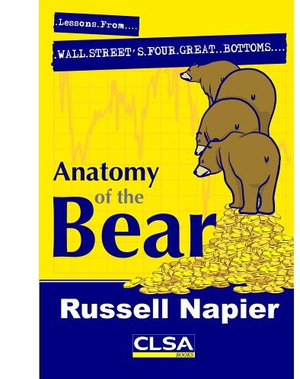 Time to brush up on what happens during a Bear Market, via Anatomy of the Bear.
Time to brush up on what happens during a Bear Market, via Anatomy of the Bear.
“How does one spot the bottom of a bear market? What brings a bear to its end? Financial market history is a guide to understanding the future.”
Looking at the four occasions when US equities were particularly cheap – 1921, 1932, 1949 and 1982, Russell Napier sets to answers these questions by analysing every article (70,000!) in the Wall Street Journal of either side of the market bottom.
Can this method help one to understand the features which indicate that a great buying opportunity is emerging?
By looking at how markets really did work in these bear-market bottoms, rather than theorising how they should work, the author offers a how to guide.
Source:
Anatomy of the Bear: Lessons From Wall Street’s Four Great Bottoms
Russell Napier,
December 5, 2005


It’s “out of stock.” Gee, I wonder why?
Off topic: April Gold Futures at the CBT:
http://finance.yahoo.com/q?s=ZGJ08.CBT
gapped upwards from $920 to more than $1,000 in the last twenty minutes!
WTF?
And now Gold is back to $930.
WTF?
About Gold,
Yes, it’s a precious metal but it is subject to speculation when fear reigns. What to do? Well, right now I heard that deposits required for futures option contracts went from 10 to 20%. If that’s on the level, considering the liquidity problems around, a pack of people raced out of gold and commodities. Again, this is a sore subject with me. I’m not an economist but I’ve got an extensive science and business education. That said, I insist that the ACTUAL price of anything (stocks, gold, wheat, etc.) should be based on ACTUAL transactions, not option bets. Granted, some big pocket individual could game a security or a commodity by buying a large amount (cornering the market) but the Hunt brothers tried that with silver and it didn’t work out too well. There is too much gaming going on. My solution is to drop the pricing formulas. Knowing that won’t happen any time soon, I suggest that a buyer of ANYTHING study the 200 day moving average and base your decisions on that. My reasons are complicated but I look at the buy sell cycle combined with market mood and liquidity. There is more but the 200 day defines the main trend. Finally, in a bear market the 200 day moving average can be halved (rule of thumb) because price manipulation is more limited (higher risk on a short than a long). It takes work but prudent study gives good rewards.
W_T_F,
I don’t see the move from $920 to $1000, just to $932 so likely a blip or error. Don’t forget that TOCOM is closed today for their holiday so trading is likely very thin.
I always think of that book when I hear some talking head on bubblevision blathering on about some stock being a good value because its forward PE is 15 (or more). Double what it should be at a long term bottom plus based on some analyst’s wet dream of the [likely misstated] past projected infinitely into the future.
Thanks much BR. I ordered one of the used copies available. If anybody’s interested,there’s a long voice only interview with Russell Napier ( a quite definite Edinburgh burr there ) at:
http://www.wallstreetreporter.com/page.php?page=featured&tab=2&id=27637
-K
just another guy trying to make a buck off
the current bear market.
You can make millions, why wait for the bottom ??
Bottoms usually happen after the necessary structural or rule changes occur in the economy.
Has that happened yet?
Things were made much worse by allowing investment banks to borrow unlimited money from the Fed. Prepare for the mother of all bubbles.
Allowing the IB’s access to the Fed’s balance sheet?
All they did was allow the Thugees into the house but they didn’t take away their weapons.
It’s a great book and was written over a year ago. Amazing amount of research. His firm, CLSA puts out some great research and their strategist Chris Wood predicted the structured finance implosion as far back as 2003. I’m going to re-read this book starting this weekend.
Late to the party on this one, but this guy Napier was interviewed by Jim Puplava when the book was released, May 2006. Here’s the link to the interview:
http://www.netcastdaily.com/broadcast/fsn2006-0415-2b.mp3